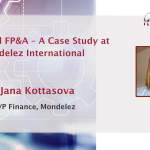Sile Lillis, Finance Director at Mitie, knows from her experience that achieving integration is possible even...

As part of the finance function, traditional FP&A teams used to work within an isolated environment, utilised specific processes and tools, possessed a “masters of the numbers” mindset, and delivered extensive Excel files, including data of questionable business value. While this “accounting” and “controlling” focus is essential, we have to answer if it is enough in the current complex and ambiguous business environment. The clear answer is no, it is not. It might be the starting point, but it is not enough: on the one hand, it’s insufficient to elevate the role of finance in an organisation and, on the other hand, to provide the business with the real value an FP&A team can and shall offer.
So, what shall FP&A teams do to provide the business with real value? What is the way forward?
Integrated FP&A is the answer. By moving towards an Integrated FP&A model, the FP&A teams should go beyond the traditional finance and accounting mindset, integrate with the entire organisation, come closer to the business, understand it, and enable it to make value-adding decisions, ultimately leading to optimised performance. Integrated FP&A offers FP&A teams the opportunity to leverage their central position within the business and wide access to information and data to bring together the Strategic, Financial, and Operational plans. It is not a luxury. It is a necessity for an organisation to navigate the business environment that demands agility.
Why do We Need to Be Agile?
Agility is essential for all companies. It is more than critical for enterprises in the scale-up phase. Scale-up organisations may experience hypergrowth, scale rapidly to achieve profitability, lack solid foundations as they are still building them, and have higher exposure to market volatility and external events. As a result, they are more susceptible and must be able to respond, adapt and pivot to survive or thrive. A fast-paced world requires fast decision-making, and fast decision-making requires all parties to play the same music, making Integrated FP&A an absolute need.
What to Consider Before Embarking on a Journey to Integrated FP&A?
Implementing an Integrated FP&A model in a scale-up business is a long journey. The biggest challenge is the lack of basic foundations and an established Finance Operating Model. As a result, the FP&A teams need to build the plane while flying it! At the same time, this is an opportunity as the implementation does not require substantially transforming a well-established organisation.
Successful implementation starts with the following:
a) establishing the required processes and
b) implementing the necessary technology.
In a scale-up environment, these first two steps may take place in parallel as the processes and technology need to be built from scratch.
The processes need to be simple and streamlined to enable efficient and time and cost-effective operations. At the same time, they must facilitate collaboration, bringing the whole organisation closer. For example, a budget mechanism may be composed of four distinct phases - Preparation, Alignment, Execution and Review, with the 2nd phase being the most critical. During this phase, the FP&A team is responsible for leading and coordinating a business-wide cross-functional action plan aimed at aligning the Strategic, Financial, and Operational plans. The team must ensure the different plans feed each other, aligning cross-functional interests and inputs/outputs and ultimately enabling the development of a budget that connects the dots and incorporates all business aspects.
The technology that will be selected and implemented must be able to fully support the established processes. At a first basic level, the technology shall be able to automate repetitive transactional work and low-value manual tasks and streamline processes to improve productivity and enhance data quality. At the second level, the technology shall enable cross-functional collaboration, integrate business processes, and improve the availability and accessibility of data and information flow across all organisational functions. Finally, it shall boost the analytical and communicative capabilities, enabling the FP&A team to unlock data, extract actionable insights, and communicate them efficiently and effectively.
Building the processes and the technology is very important. Both will be operated and run by people. That is why nothing can be achieved without the FP&A team developing the appropriate mindset and culture and managing to establish themselves as trusted finance Business Partners.
To do so, the FP&A teams need to invest in training, coaching and mentoring to continuously upskill themselves and build the necessary muscles. Of course, excellent analytical skills are the absolute minimum to enable data-driven decision-making and optimal business performance. It is equally important, though, to master communication and stakeholder management as well as to develop the business acumen that will enable them to see beyond financials. At the same time, FP&A teams need to be structured in a way that will enable them to come closer to the business. While mirroring how the company is organised could be the starting point, FP&A teams can remain flexible and innovative. It is important to ensure they are structured in a way that allows them to allocate the time and the required resources to collaborate with the business stakeholders.
Finally, the skills and the structure must be complemented by a “best-in-class” mindset. FP&A teams need to define success, set expectations, agree on them and develop the internal mechanisms to operate at the highest standards.
Conclusions
To conclude, FP&A teams in scale-up organisations have the unique opportunity to establish an Integrated FP&A “modus operandi” from day one. They have the unique opportunity to set up the processes, implement the technology and develop the necessary skills. Structure and mindset will enable them to leverage their central position within the business, act as trusted finance Business Partners and deliver real business value. They will deliver value by managing to connect the Strategic, Financial and Operation Plans, developing dynamic models and multiple business scenarios, and contributing to organisation-wide data-driven optimised decision-making. The business will be equipped with flexibility, adaptability and agility, boosting performance and managing to scale up within an ambiguous and volatile environment.
Subscribe to
FP&A Trends Digest

We will regularly update you on the latest trends and developments in FP&A. Take the opportunity to have articles written by finance thought leaders delivered directly to your inbox; watch compelling webinars; connect with like-minded professionals; and become a part of our global community.






